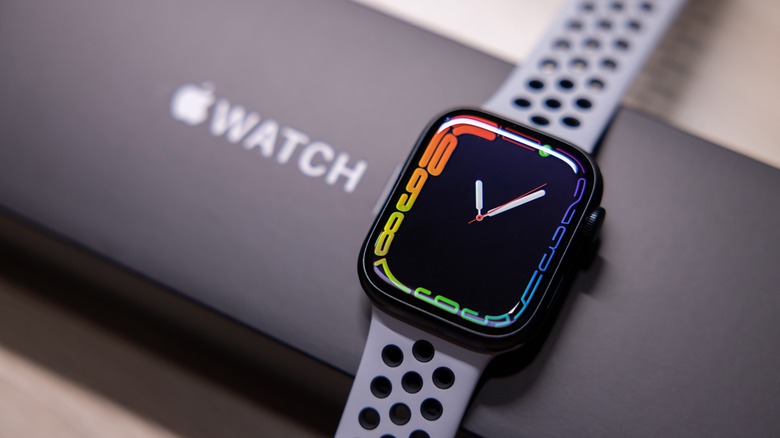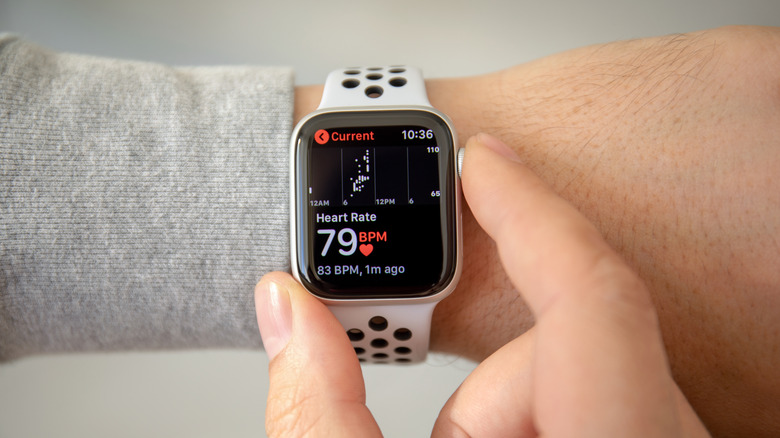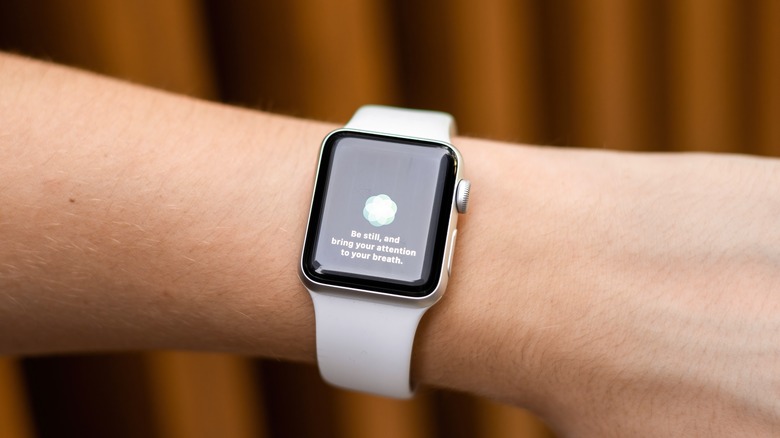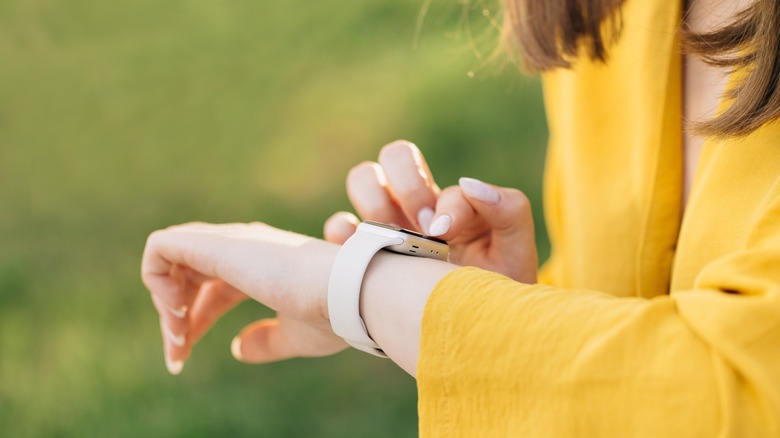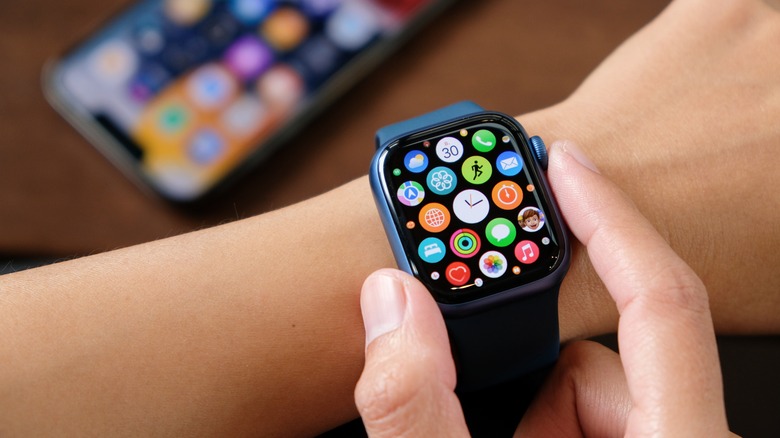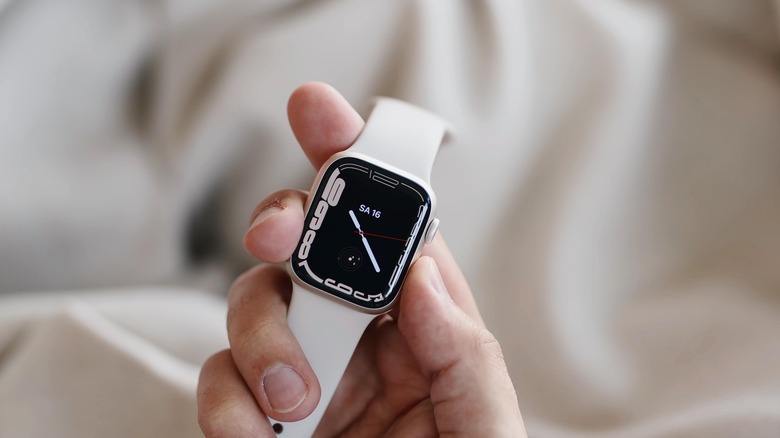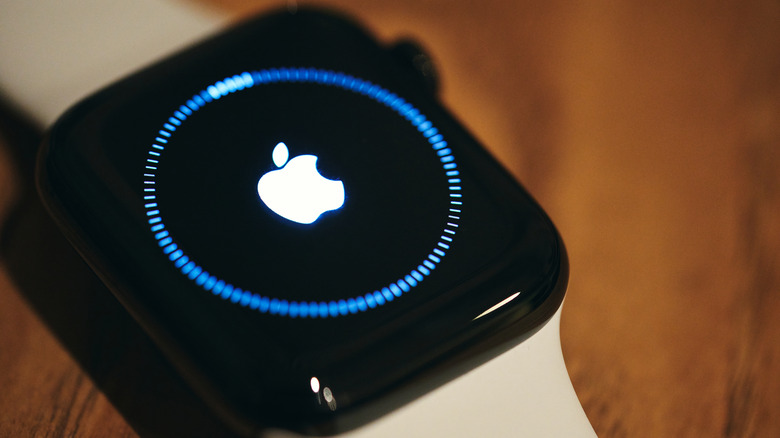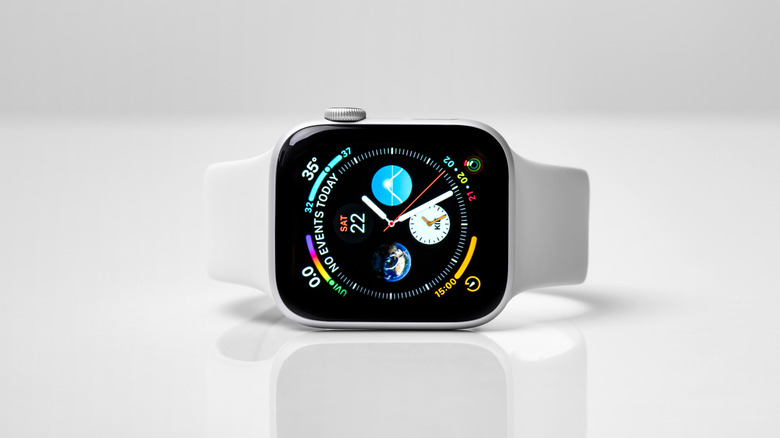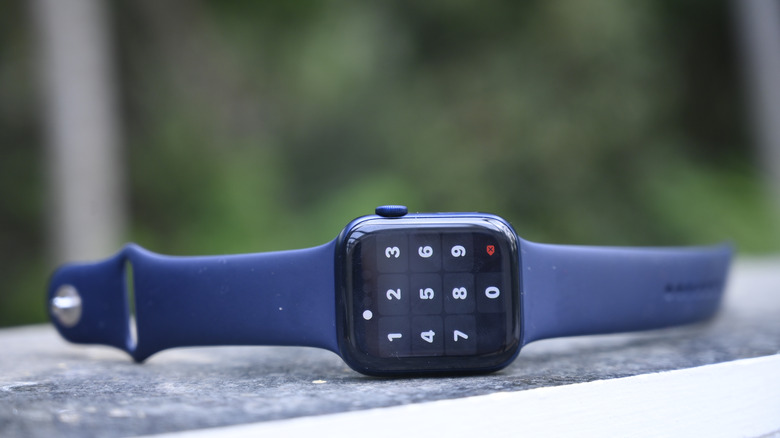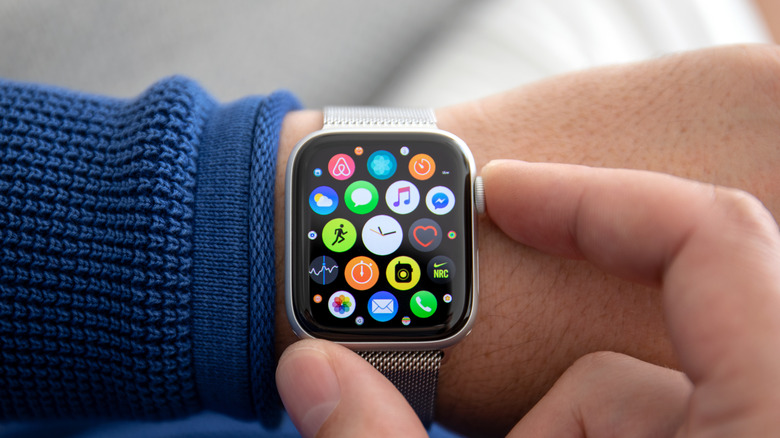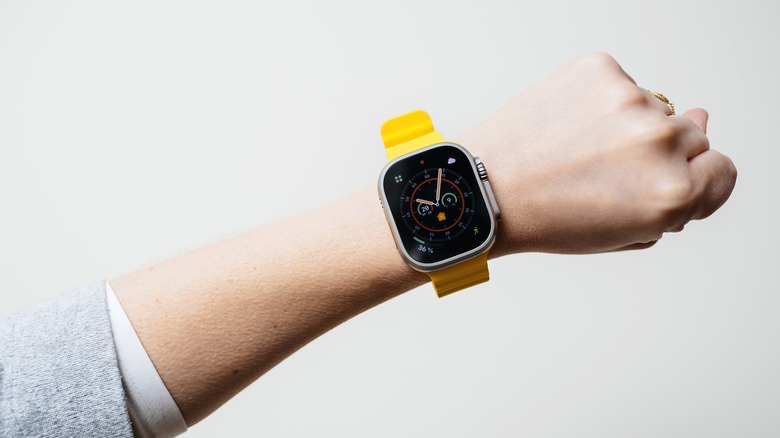Settings On Your Apple Watch That Are Ruining Your Experience
Who could have anticipated something like smartwatches becoming such a polarized topic? People bicker constantly online, unable to reach common ground on when, exactly, it's okay to wear a smartwatch, and when it's not appropriate — like when wearing black-tie clothes or going to a job interview. Photographers pick on their clients for keeping Apple Watches on during photoshoots, and USA Today notes that especially vocal social media users say that 24/7 smartwatch-clad people look like dorks, comparing them to "Spy Kids" from the movie with the same name. Rebuttals usually point out that Apple Watches track critical health data for users with medical conditions, that watch bands and faces can be changed out for more classy looks, and that a smartwatch means you can still communicate even if you misplace your phone.
Whether you agree with one of those opinions or share our thoughts on the matter —which is that it's not that serious, and people who argue online over what kind of watches you should wear to a wedding are weird — it can't be debated that smartwatches bring a ton more utility to your fingertips than a traditional watch does. With a cellular-connected smartwatch, it's no big deal to go for a walk or run to the store without your phone — not because it's impossible to go a few minutes without it, but because smartwatches give us peace of mind that we can still reach someone or be reached by someone if there is an emergency. But if your Apple Watch experience has been subpar, don't revert back to your old Fossil timepiece yet. Here are some setting changes to make that may improve your smartwatch experience.
The heart rate monitor
If your Apple Watch's battery is drained before your first cup of coffee in the morning, you may want to take a closer look at how the watch's power is being consumed. A likely culprit is the heart rate monitor which, while a great tool for wearers that need constant heart rate monitoring, may not be something you need to be activated if you have no history of heart issues. On the reverse, if you have concerns about fibrillation or other heart problems, you may want to capitalize on the Apple Watch's impressive cardiogram capabilities.
How can you enable 'round-the-clock heartbeat monitoring on an Apple Watch? While Apple Watches don't continuously check heart rates, they can be programmed to read your pulse as often as every five seconds (in watches that can run at least WatchOS 6.2) using third-party apps like Cardiogram. By default, an Apple Watch will check your heart rate every 10 minutes, and store that information in your health app. The watch will scan even more frequently if you are working out, and in the minutes after a workout has been completed.
Battery life woes? Consider disabling heart rate monitoring to prolong your watch's battery life. This function can be easily toggled off and on in an iPhone's Watch app, so if you only want the watch's heart monitor on when you work out and sleep, for example, getting into the habit of turning it off and on is a great way to preserve battery during the day.
The Breathe reminders
Have you ever been stuck on hold in an annoying customer service call, engrossed in a heated back-and-forth with a coworker, or fuming over a new piece of furniture that just won't come together even with the instructions? These moments are agitating enough, but there's nothing to tip the scales quite like that infamous "Breathe" reminder popping up on your Apple Watch at the zenith of your frustration in these scenarios. Breathe reminders come from a native Apple Watch application, also called Breathe. It's a simple app that guides users through short periods of medication and mindful breathing. This app can be deleted altogether, but it is a nice tool to have and manually open when you need some help re-centering after things get heated.
By default, the Breathe app is programmed to remind users to "bring attention to your breath" at predetermined times throughout the day. We can certainly give some appreciation to Apple's intentions behind this setting in theory, but the reminder to breathe can just feel more taunting than anything in practice. Contrary to popular belief, your Apple Watch doesn't tell you to breathe because it detected a heart rate spike or other stress level indicator but you can change the frequency of how often the notifications occur, with a maximum of 10 Breathe notifications per day — or, you can turn them off altogether if you find the watch's cheerful reminder to be less stressed during periods of stress to be doing more harm than good.
Quiet delivery and notification filters
Fortunately, an Apple ecosystem is pretty intelligent about where to send notifications when multiple devices within the system — like a phone, an iPad, a watch, and a laptop — are all on and actively being used. But even Apple devices aren't perfect in this regard and getting a ding for every single email, every shopping app's sale, and every mobile game enticing you to come back and play again can get overwhelming enough that you just want to leave your watch at home. If you feel like an endless stream of notifications are ruining your Apple Watch experience, there are more solutions than resorting to do not disturb mode.
Using the Watch app on iPhone, pick and choose which applications are allowed to send notifications to your Watch in addition to your phone and other devices. You can also choose which apps are only allowed to notify you when your wrist is up — i.e. when your watch is awake — and which can notify you even when your wrist is down. If a particular app is bombarding you with notifications, you can force the app's pings into quiet delivery directly from the watch.
The wrist-wake settings
The wrist-wake settings on an Apple Watch describe whether your wrist is up — which wakes up the watch's screen — or down, which triggers the watch to sleep. If a too-short battery life is plaguing you as an Apple Watch user, turning off the wrist-wake settings is a good practice to prolong the battery life. This can also help if you've ever found your Apple Watch to just be too distracting.
However, if you don't feel like you're getting the bang for your buck out of an Apple Watch, disabled wrist-wake settings may be why. This capability is part of what sets smartwatches apart from traditional timepieces and makes hands-free call answering, text reading, and notification checking hassle-free. An easy way to temporarily disable wrist-wake settings in order to lessen distractions or preserve battery is by enabling theater mode — but keep in mind that this will also put your watch on silent.
The always-on display
You may have taken your Apple Watch one step past the wrist-wake settings and put it into always-on mode. Basically, this means the watch will never go to sleep, even if you remove it until it's powered off or put on the charger. This is a useful tool for Apple Watches that are Series 5 and later, in which the always-on display summarizes information, like the time and any timers you've set, while less critical details, such as the compass, are turned off. The watch does so on a dimmed screen that uses very little energy to create static movement when you're looking at your watch, and an even dimmer and more simplified screen when your watch is in wrist-down mode. On newer watches, you definitely want to make the most of this feature in order to make the most of your watch.
But if you are using an older watch than the Series 5, your device's display is not well equipped for always-on settings. Even at the lowest brightness setting, an older Apple Watch may have a harder time keeping up with always-on settings than a Series 5 or later. So if you find that your watch's battery is in the red before noon and you've set it to always-on, turning that off will significantly improve the battery life.
Out-of-date software
If your Apple Watch has gradually gotten more buggy, slower, and overall less agreeable with new applications, don't chalk it up to the old device curse just yet. Running an out-of-date WatchOS could be why your experience with an Apple Watch has turned sour. Just like other Apple devices, the smartwatch's software updates can be installed automatically, but there are several factors that may get in the way of autonomous software installs such as a prolonged time with no wifi connection, a watch that isn't put on its charger for adequate periods of time, or issues with the paired iPhone. According to Apple, while you technically shouldn't need your iPhone if your watch already runs WatchOS 6 or later, out-of-date iOS on the phone or a broken pairing between the phone and watch may be preventing updates from occurring.
It is definitely a good idea to keep your smartwatch up to speed on the most recent software, as this could not only keep the device running smoothly but also address any bugs related to operations or security that you may not even be aware of. WatchOS 9 is the latest version of the Apple Watch operating system as of this article's publishing, but we have bad news for Series 3 users — your devices are officially considered too old for this software update, so you're faced with upgrading your watch or using it until it goes kaput.
The display complications and widgets
The display complications (meaning the modules or widgets you can put on the main display face of the watch along with the time) are another two-sided coin when it comes to maximizing the Apple Watch experience. Especially with an entire gallery of watch faces at your disposal in the Watch app, it's tempting to try out them all and use the most complex, high-tech-looking face that tells you your local time, London time, today's weather, the weather a week from now, real-time barometric pressure, your rings, your heart rate, your neighbor's heart rate ... The point is, there's a lot that you can put on the face of an Apple Watch, so you may be undermining your watch's potential by using a minimalist face with nothing but the time — or even one of those clock faces with no numbers. Honestly, aren't we past those?
On the other hand, you may find that too many complications makes your head spin. It can be overwhelming to look at when you're just glancing down for the time — or maybe the smaller text and numbers becomes an eyesight-related issue when more and more modules are added. A simple watch face with a digital time, date, and maybe the real-time outside temperature is a great happy medium. Plus, reducing the number of complications on your home screen may improve battery life by removing some stress from constant refreshing.
Passcodes
Who doesn't want their personal devices to be more secure? There's no harm in adding another layer of protection between your sensitive data and prying eyes. Passwords on computers and phones are pretty normal, and all Apple Watch Series models are capable of being locked with a passcode. However, passcodes on smartwatches are tricky and none too convenient. One somewhat helpful function in the Apple ecosystem is the "Unlock with iPhone" feature, which means that your watch will be automatically unlocked when your iPhone is unlocked. However, the watch will then remain unlocked, even if you put your wrist down and the watch face goes to sleep until the device is once again removed from your wrist. This doesn't protect your watch in any way while you're using it.
And if you turn on a watch passcode without the automatic unlock-with-iPhone feature, you must manually enter your passcode every time you wake the watch up, since Apple Watches aren't capable of FaceID reading ... yet. This turns into a huge hassle when trying to check the time or use your watch while you're hands aren't free.
Recent or favorite apps on dock
Access the Apple Watch dock by pressing the side button while the device is awake, then either swipe (up or down) or turn the knob on the other side. This menu, by default, shows your 10 most recently accessed applications. You might feel like you're getting more use out of an Apple Watch if you change the dock setting from recently-used applications to your own set of favorite applications. This helps if, for example, you don't regularly use AirBnB, but are getting tons of notifications for an upcoming trip and don't want the app to take up a space in your dock, or if you don't regularly open the Health app but want fast and easy access to it when you do need it.
When choosing your favorite apps, you also can choose the order of applications in your dock, helping prioritize what is most needed (although Apple designed the watch to reserve the top slot of the dock for the most recently used app, even if your preferences are set to favorite). Favorites must be designated and reordered on the iPhone Watch app, but can be removed from either your phone or your watch.
Background app refresh
While it seems logical that allowing your smartwatch's apps to refresh more would be harder on the battery, the opposite is actually true. Background app refresh on Apple Watch is meant to maximize your battery — it does so by freeing up RAM while your watch is running since apps aren't working so hard to gather data and get up to speed when you reopen them. If you've turned off background refreshing, you may find that your apps have started taking longer to open for this purpose; they're sending out one big ping rather than more frequent smaller ones.
One area where background refreshing siphons from your watch is in cellular data. You can adjust settings to only background refresh when connected to wifi, but otherwise, your watch (assuming it has a data connection) will draw on cellular data to refresh apps in the background. It seems a catch-22 — to background refresh or not to background refresh — but if this setting is disabled on your watch and you find the battery life suffering, try turning it back on. On the other hand, if data consumption is an issue, toggle the setting to off. Apps may still run slowly even if background refresh is on; this could be a WatchOS issue, a slow data connection, or the device becoming overwhelmed by its operations plus the background refreshing. In this case, turn the background refreshing off and see if your watch's performance improves.
